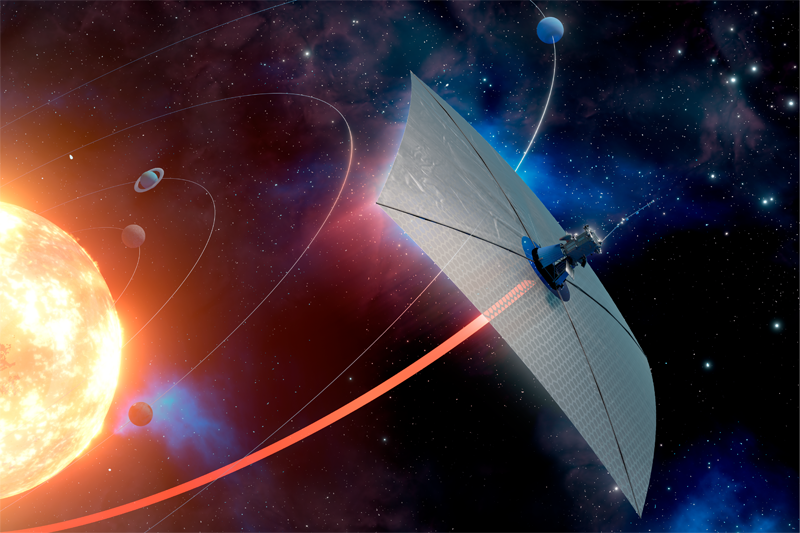Race to Sedna: New fusion and solar sail engines could reach distant world in 10 years
Two advanced propulsion concepts could bring a spacecraft to Sedna in under 10 years, revealing secrets of the early solar system.

Solar sails and fusion drives could transform deep space travel. (CREDIT: Artur Davoyan and Ella Maru Studio)
In the frozen outskirts of the solar system, a reddish dwarf planet orbits in silence. Known as Sedna, it is so distant that one trip around the Sun takes more than 11,000 years. For much of that time, it remains far beyond Neptune, past the Kuiper Belt, and possibly within the mysterious region known as the inner Oort Cloud. Now, with Sedna nearing its closest approach to the Sun in 2075–76, a rare opportunity is emerging. Scientists want to reach it—before it drifts away again into the dark for centuries.
This goal has ignited growing interest in a mission that would travel farther than any spacecraft has ever gone. But such a mission can’t rely on the same old rockets. Instead, researchers are exploring two advanced propulsion systems: a Direct Fusion Drive (DFD) and a solar sail using thermal desorption. Each method brings unique challenges, yet both could reshape our ability to explore the outer solar system.
Why Sedna Matters
Discovered in 2003, Sedna is no ordinary object. Its orbit stretches from around 76 astronomical units (AU) at perihelion to an astonishing 936 AU at its farthest point—31 times farther than Neptune. That places it well beyond the reach of traditional missions and positions it as a key to understanding how the solar system formed.
Sedna is thought to be one of the most primitive objects in the solar system. Its reddish surface hints at a rich mixture of organic compounds, methane ice, and possibly water ice. Because it spends so little time near the Sun—just 2% of its 11,400-year orbit—its surface has been protected from heat and radiation. That makes Sedna a time capsule, possibly containing information about the solar system’s earliest materials.
Some scientists have even suggested that Sedna might not have formed in our solar system at all. It could be an exoplanet that was captured long ago during a close encounter with a passing star. Proving that would require in situ sampling and detailed analysis. If true, Sedna could be the first known exoplanet humanity can study up close.
The Challenges of Reaching Sedna
Reaching Sedna is no easy task. The distance alone makes the journey daunting. Even the fastest spacecraft today would take more than 30 years to get there. During that time, communication delays could reach up to 13 hours one way. Navigation and course corrections over such vast distances would have to be extremely precise, with limited opportunities to fix mistakes.
Related Stories
The spacecraft must also survive the harshest conditions imaginable. Temperatures near Sedna never exceed −240°C. Power sources like solar panels are almost useless that far from the Sun, meaning a mission would rely on radioisotope thermoelectric generators or nuclear fusion. Shielding would be critical too, as the spacecraft travels through regions full of cosmic rays and micrometeoroids.
Sedna’s slow motion near perihelion offers a window of opportunity. It will remain within 85 AU of the Sun for about 50 years and within 100 AU for 200 years. This gives some flexibility in launch timing, but any delay could reduce the value of the science return. If a mission is going to happen, it needs to launch by the mid-2030s.
New Propulsion Technologies
To reach Sedna in time, scientists are turning to two bold ideas. One of them, the Direct Fusion Drive, is being developed at the Princeton Plasma Physics Laboratory. This rocket engine uses D-³He fusion to create both thrust and electric power. It generates between 1 and 10 megawatts of power and offers continuous acceleration—a huge advantage over chemical rockets.
The team assumes a 1.6 MW system, providing steady thrust over 1.5 years. That could cut travel time to about 10 years. The DFD is capable of inserting the spacecraft into orbit around Sedna, allowing extended study.
But the DFD is still in the experimental stage. Fusion containment, heat dissipation, and operational endurance remain major engineering hurdles.
The second approach involves a more familiar concept—solar sailing—but with a twist. Solar sails use the pressure of sunlight to propel a spacecraft without fuel. This new version adds a thermal desorption layer. When heated near the Sun, this coating releases particles that add extra thrust. Combined with a gravity assist around Jupiter, this technique could shorten the journey to just seven years.
While faster, the solar sail would allow only a flyby, not orbit insertion. It wouldn’t provide the prolonged observation time of an orbital mission. However, its simpler design and fuel-free propulsion make it an attractive near-term option.
Planning the Mission
The two propulsion systems lead to very different mission profiles. A DFD-powered spacecraft could carry heavier scientific instruments and stay near Sedna longer, providing higher-resolution data. It could use mass spectrometry, infrared spectroscopy, and laser-induced breakdown spectroscopy to study Sedna’s surface and potential atmosphere. These tools might even help test the exoplanet capture theory by analyzing isotopic compositions.
On the other hand, the solar sail would need to make the most of a brief encounter. Cameras, magnetometers, and spectrometers could capture critical data during a flyby. This is similar to how New Horizons studied Pluto, although with less time and at greater distance.
Both missions face limits on communication. Signal strength from Sedna’s distance would be very weak, with data rates under 1 kilobit per second. Powerful antennas on the spacecraft and deep-space ground stations on Earth would be needed. Data would likely be sent back over months or even years, similar to how New Horizons and JUICE operate.
Navigation presents another hurdle. Tiny errors in course could lead to massive deviations over billions of kilometers. Spacecraft would need autonomous systems to handle guidance, control, and fault recovery. Advanced star trackers, optical navigation, and careful planning of gravity assists would all play key roles.
Attitude control is especially difficult for solar sails. Traditional systems using thrusters or gyros can’t be used without propellant. Engineers are exploring methods like adjusting membrane reflectivity to steer the sail by shifting the center of pressure. These ideas, discussed recently at the International Space Sailing Symposium, may offer new solutions for long-distance sailcraft control.
What’s Next?
A new feasibility study led by Elena Ancona from Politecnico di Bari and posted to arXiv highlights the trade-offs between these two technologies. The DFD can enable deep exploration but needs major breakthroughs in fusion. The solar sail is more realistic for now but limits science return to a quick flyby.
Either way, the race is on. Sedna won’t be this close to Earth again for thousands of years. If we want to study it in detail, a spacecraft needs to launch within the next decade. The technology exists—or is close. What remains is the commitment to take the leap.
This mission could redefine how we explore the solar system’s edge. Whether with a burst of fusion power or the whisper-push of sunlight, the path to Sedna marks a bold new chapter in human spaceflight.
Note: The article above provided above by The Brighter Side of News.
Like these kind of feel good stories? Get The Brighter Side of News' newsletter.



